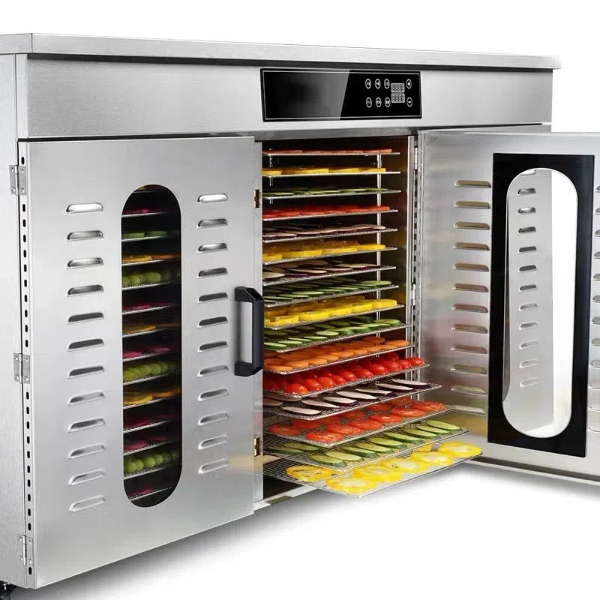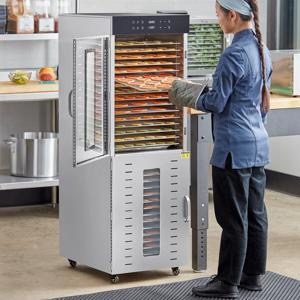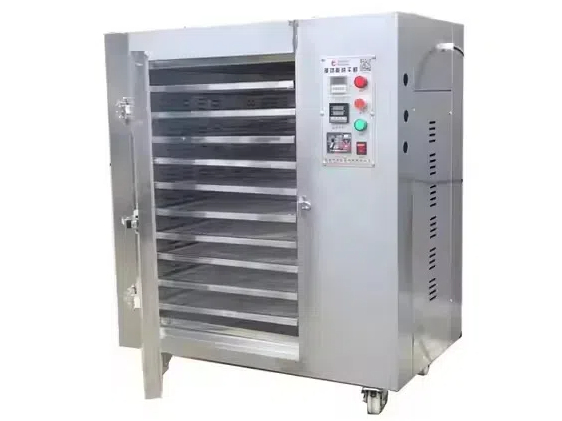
Content Menu
● Understanding Cabinet Type Dehydrators
● Pros of Cabinet Type Dehydrators
● Cons of Cabinet Type Dehydrators
● Tips for Using a Cabinet Type Dehydrator
● Maintenance of Cabinet Type Dehydrators
● Conclusion
● FAQ
>> 1. How long does it take to dehydrate food in a cabinet dehydrator?
>> 2. What is the ideal temperature for dehydrating different types of food?
>> 3. Can I dehydrate more than one type of food at the same time in a cabinet dehydrator?
>> 4. How do I know when dehydrated food is done?
>> 5. How do I store dehydrated foods to maintain their quality?
● Citations:
Food dehydration is an age-old method of preserving food, extending its shelf life while concentrating its flavors and nutrients. In modern times, this process has been revolutionized by electric food dehydrators, particularly cabinet-type models. These dehydrators offer precise control and consistent results, making them a popular choice for home use. However, like any appliance, they come with their own set of advantages and disadvantages. This article delves into the pros and cons of cabinet-type dehydrators, helping you make an informed decision about whether one is right for your needs.

Understanding Cabinet Type Dehydrators
Cabinet dehydrators, also known as box-type dehydrators, are characterized by their enclosed design, resembling a small oven or cabinet. Inside, multiple trays slide in and out, providing ample space for dehydrating various foods simultaneously. The heating element and fan are typically located at the back of the cabinet, ensuring even heat distribution throughout the interior.
Compared to other types of dehydrators, such as stackable models, cabinet dehydrators offer greater control over temperature and airflow. This precise control is crucial for achieving consistent results and preserving the quality of dehydrated foods.
Pros of Cabinet Type Dehydrators
1. Precise Temperature and Airflow Control: One of the most significant advantages of cabinet dehydrators is their ability to maintain consistent temperature and airflow throughout the drying process. This is achieved through a combination of a thermostat-controlled heating element and a fan that circulates air evenly across all trays. This precise control ensures that foods are dehydrated uniformly, preventing some pieces from being over-dried while others remain moist.
2. Large Capacity: Cabinet dehydrators typically offer a larger capacity than stackable models, allowing you to dehydrate more food at once. This is particularly beneficial if you have a large garden, buy produce in bulk, or simply want to prepare a significant amount of dehydrated snacks.
3. Even Dehydration: The consistent temperature and airflow within a cabinet dehydrator contribute to even dehydration. This means that all the food on every tray dries at the same rate, eliminating the need for manual tray rotation. This not only saves time and effort but also ensures that the final product is of uniform quality.
4. Versatility: Cabinet dehydrators are suitable for dehydrating a wide variety of foods, including fruits, vegetables, meats, herbs, and even flowers. The ability to control temperature and airflow allows you to customize the drying process for different types of food, ensuring optimal results every time. For example, delicate herbs can be dehydrated at a lower temperature to preserve their flavor and aroma, while thicker cuts of meat can be dried at a higher temperature to ensure they are thoroughly preserved.
5. Extended Shelf Life: By removing moisture from food, cabinet dehydrators significantly extend its shelf life. Dehydrated foods can be stored for months or even years without spoiling, making them a convenient and economical way to preserve seasonal produce and reduce food waste.
6. Nutrient Preservation: While some nutrients are lost during the dehydration process, cabinet dehydrators excel at preserving a significant portion of the natural vitamins, minerals, and enzymes found in fresh foods. The controlled drying process minimizes degradation, ensuring that the dehydrated products retain their nutritional value. Dehydrated fruits and vegetables make for healthy snacks that can be enjoyed any time of year.
7. No Tray Rotation: Cabinet dehydrators don't usually require tray rotation during the drying process, as their design ensures uniform heat and airflow distribution.
8. Energy Efficiency: Compared to other food preservation methods like canning or freezing, cabinet dehydrators can be more energy-efficient. They use less energy over a long period than a freezer continuously running or the high heat required for canning.
9. Easy to Clean: Many cabinet dehydrators come with removable trays and components that are dishwasher safe, making cleaning a breeze. This is a significant advantage for busy individuals who want to spend less time on cleanup.
10. Quiet Operation: Many cabinet dehydrators operate relatively quietly, making them suitable for use in homes without disturbing the household.

Cons of Cabinet Type Dehydrators
1. Cost: Cabinet dehydrators tend to be more expensive than stackable models. The higher price reflects the more sophisticated design, precise controls, and larger capacity. If you are on a tight budget, a cabinet dehydrator may not be the most affordable option.
2. Size and Storage: Cabinet dehydrators are generally larger and bulkier than stackable models. They require more counter space during operation and can be more challenging to store when not in use. If you have a small kitchen or limited storage space, you may need to consider a smaller dehydrator.
3. Initial Investment: The upfront cost of a cabinet dehydrator can be significant, especially for high-end models with advanced features. This can be a barrier for some users, particularly those who are new to food dehydration. However, it's important to consider the long-term benefits of owning a cabinet dehydrator, such as reduced food waste and the ability to create healthy, homemade snacks.
4. Drying Time: Dehydrating food can take a considerable amount of time, ranging from several hours to several days, depending on the type of food and the desired level of dryness. This requires patience and planning, as you'll need to factor in the drying time when preparing your recipes.
5. Potential for Over-Drying: While cabinet dehydrators offer precise control, there is still a risk of over-drying food if the temperature is set too high or the drying time is too long. Over-dried food can become brittle, tough, and lose its flavor. To prevent over-drying, it's essential to follow the manufacturer's instructions and monitor the food closely during the drying process.
6. Noise: Although many cabinet dehydrators operate quietly, some models can produce a noticeable hum or fan noise, which may be bothersome to some users. If you are sensitive to noise, it's essential to choose a dehydrator that is known for its quiet operation.
Tips for Using a Cabinet Type Dehydrator
-Prepare Food Properly: Cut food into uniform slices or pieces to ensure even drying. Pre-treat fruits with lemon juice to prevent browning.
-Load Trays Evenly: Arrange food in a single layer on the trays, leaving space for air to circulate. Avoid overcrowding, as this can impede airflow and result in uneven drying.
-Monitor Drying Progress: Check the food regularly during the drying process and adjust the temperature or drying time as needed. Use a food thermometer to ensure that meat and poultry reach a safe internal temperature.
-Store Dehydrated Foods Properly: Store dehydrated foods in airtight containers in a cool, dark, and dry place. This will help to prevent moisture absorption and maintain their quality.
Maintenance of Cabinet Type Dehydrators
-Clean After Each Use: After each use, clean the trays and interior of the dehydrator with warm, soapy water. Remove any food particles or residue to prevent bacterial growth.
-Descale Regularly: If you live in an area with hard water, descale the dehydrator regularly to remove mineral deposits. Follow the manufacturer's instructions for descaling.
-Inspect for Damage: Periodically inspect the dehydrator for any signs of damage, such as cracks, frayed cords, or loose connections. Repair or replace any damaged parts to ensure safe and efficient operation.
Conclusion
Cabinet-type dehydrators offer numerous advantages for home food preservation, including precise control, large capacity, even dehydration, and versatility. However, they also come with some drawbacks, such as higher cost, larger size, and the potential for over-drying. By carefully considering the pros and cons, as well as your individual needs and preferences, you can determine whether a cabinet-type dehydrator is the right choice for you. If you value convenience, control, and consistent results, a cabinet dehydrator can be a worthwhile investment that will allow you to enjoy healthy, homemade dehydrated foods for years to come.

FAQ
1. How long does it take to dehydrate food in a cabinet dehydrator?
The drying time varies depending on the type of food, the thickness of the slices, and the temperature setting. Generally, fruits and vegetables can take anywhere from 6 to 24 hours to dehydrate, while meats can take even longer. It's essential to monitor the food closely and adjust the drying time as needed.
2. What is the ideal temperature for dehydrating different types of food?
The ideal temperature varies depending on the type of food. Fruits and vegetables are typically dehydrated at temperatures between 130°F and 140°F (54°C and 60°C), while meats require higher temperatures of 145°F to 160°F (63°C to 71°C) to ensure they are safe to eat. Consult the manufacturer's instructions or a reliable dehydration guide for specific temperature recommendations.
3. Can I dehydrate more than one type of food at the same time in a cabinet dehydrator?
While it's possible to dehydrate different types of food at the same time, it's generally not recommended. Different foods have different moisture contents and may require different drying times and temperatures. Mixing foods can result in uneven drying and may affect the flavor and texture of the final product.
4. How do I know when dehydrated food is done?
Dehydrated food is done when it is leathery and pliable, but not sticky. Fruits should be slightly tacky, while vegetables should be crisp. Meats should be firm and dry. To test for dryness, remove a piece of food from the dehydrator and let it cool to room temperature. If it is still sticky or moist, return it to the dehydrator for further drying.
5. How do I store dehydrated foods to maintain their quality?
Dehydrated foods should be stored in airtight containers in a cool, dark, and dry place. Glass jars, plastic containers, or resealable bags are all suitable options. To prevent moisture absorption, consider adding a desiccant packet to the container. Properly stored dehydrated foods can last for months or even years.
Citations:
[1] https://www.dryeratech.com/the-ultimate-guide-to-cabinet-type-dehydrator-machines.html
[2] https://www.tsunghsing.com.tw/en/product/cabinet_type_dryer.html
[3] https://www.dryeratech.com/how-to-choose-the-right-cabinet-type-dehydrator-for-your-needs.html
[4] https://patents.google.com/patent/CN1110593C/zh
[5] https://www.foodandwine.com/lifestyle/kitchen/best-food-dehydrators
[6] https://shop.howlifeusa.com/zh/washing-machine/
[7] https://www.seriouseats.com/best-food-dehydrators-5216308
[8] http://china-dryer.com/newsclass_2/newsdetail_30.shtml











